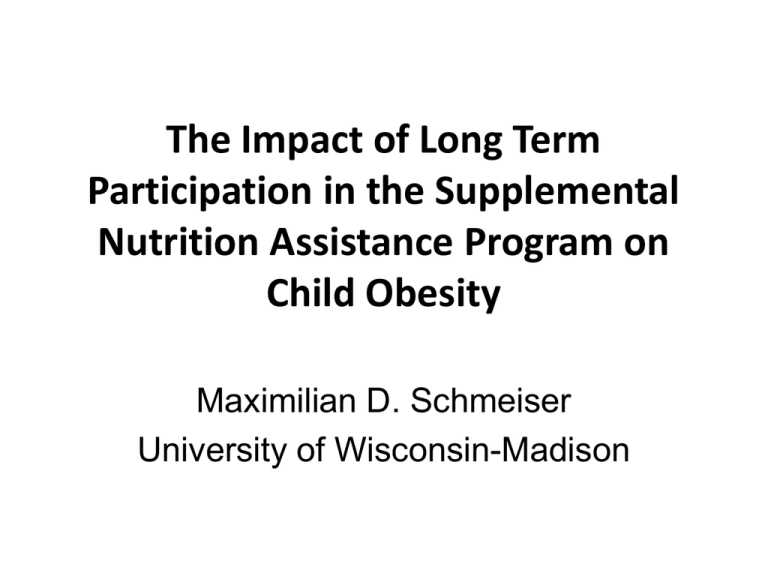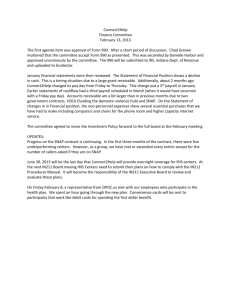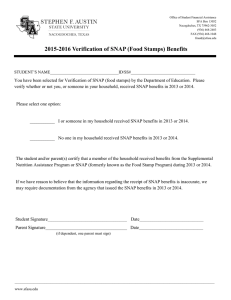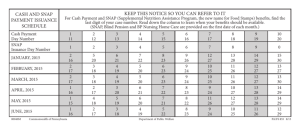The Impact of Long Term Participation in the Supplemental Child Obesity
advertisement

The Impact of Long Term Participation in the Supplemental Nutrition Assistance Program on Child Obesity Maximilian D. Schmeiser University of Wisconsin-Madison Motivation • Rapid increase in obesity over past 30 years • Obesity is most prevalent among low-income individuals • One suggested cause is participation in the Supplemental Nutrition Assistance Program (SNAP) (formerly Food Stamps) • SNAP participation has increased substantially due to recession and benefits were increased Research Question • Does participation in the SNAP program increase obesity among children ages 5 to 18? • Focus on percent of time over past 5 years child participated in SNAP since obesity is a stock measure which takes time to adjust to changes in behavior • Use an Instrumental Variables (IV) strategy to identify causal effect of SNAP participation on child obesity Background on SNAP • The Supplemental Nutrition Assistance Program is the new name for the Food Stamps Program – Emphasize nutrition aspect of program • In 2008, the program served 28 million lowincome persons, providing total benefits worth almost $35 billion • Provides benefits for the purchase of unprepared food to individuals below 130 percent of the poverty line SNAP and Obesity • How can SNAP affect obesity? • Increase Obesity: • A dollar of SNAP benefits increases the consumption of food by more than does a dollar of unrestricted cash benefits (Fox et al., 2004) • Approximately a quarter of SNAP recipients would spend less than their SNAP allocation on food were the benefits provided as cash (Whitmore, 2002) • The monthly lump sum distribution of SNAP could also contribute to obesity if it results in binge eating (Townsend et al., 2001; Shapiro, 2003) SNAP and Obesity • Decrease Obesity: • Improve nutrition by increasing family’s food budget allowing the purchase of more expensive fruits and vegetables and less processed food • Encourage eating food at home rather than food at restaurants or fast food outlets • Reduce food insecurity SNAP and Obesity • Previous research has consistently found SNAP participation to be associated with an increase in obesity for adult women (Townsend et al., 2001; Gibson, 2003, 2006; Chen et al., 2005; Baum, 2007) and female children (Gibson, 2004, 2006) • However, no previous study has effectively addressed the endogeneity between SNAP participation and obesity Data • National Longitudinal Survey of Youth 1979 cohort (NLSY79) and Children and Young Adults of NLSY79 – NLSY79 Nationally representative sample of individuals who were between the ages of 14 and 21 on December 31, 1978 – CYA of NLSY79 are data on all children born to women of the NLSY79 collected biannually since 1986 – Contains detailed demographic and economic data – Use 1986 through 2006 waves – Children ages 5 to 18 Table 1. Descriptive Statistics: Children Ages 5 to 11 Ages 5 to 11 Variable Boys Girls Obese 0.1436 0.1286 (0.3507) (0.3347) Overweight 0.2804 0.2676 (0.4492) (0.4427) Body Mass Index (BMI) 17.3381 17.3753 (3.8011) (3.8677) 5 Year Food Stamps Exposure (Percent) 16.8902 16.4918 (32.1606) (31.7049) Indicator for Self-Reported Weight and/or Height 0.2686 0.259 (0.4432) (0.4381) Observations 8684 8394 Weighted means with standard deviations in parentheses. Ages 12 to 18 Boys Girls 0.162 0.1247 (0.3685) (0.3304) 0.3253 0.298 (0.4686) (0.4574) 21.0579 21.3392 (4.5987) (4.7808) 16.3866 16.0447 (31.9109) (31.9971) 0.4508 0.4677 (0.4976) (0.4990) 8000 7648 Ages 5 to 18 Boys Girls 0.1495 0.1273 (0.3566) (0.3333) 0.2947 0.2774 (0.4559) (0.4477) 18.5243 18.6515 (4.4259) (4.5750) 16.7296 16.3478 (32.0807) (31.7986) 0.3267 0.3262 (0.4690) (0.4688) 16684 16042 Empirical Methods • LPM Model: Fist = α + β1 SNAPit + β 2 X it + β 3 Pst + ε ist i=individuals, t=time, s=state F: Obese/Overweight SNAP: Percent of time spent on SNAP over previous 5 years X: Vector of demographics (age, race/ethnicity, birth order, birth weight, whether breast-fed, mother’s age at birth of the child, number of children in the family, mother’s highest grade completed, mother’s Armed Forces Qualifying Test (AFQT) percentile score, mother’s marital status, mother’s employment status, region of residence and residence in an MSA, an indicator for mother-reported weight and/or height, and year dummies) – Time invariant demographics dropped when FEs estimtated – P: State level food price index – – – – Identification • To generate causal estimates use exogenous variation in income, which affects SNAP eligibility, generated by changes in the parameters of state and federal Earned Income Tax Credit programs • EITC is the largest anti-poverty program in the U.S. for the non-elderly – Federal expenditures in excess of $41.5 billion and over 22 million recipients in tax year 2004 (CBPP, 2007) • Functions as a wage supplement for those who have earned income Identification • Instruments generated by running entire NLSY sample through NBER TAXSIM program for each state by year combination and calculating average EITC value for EITC eligible individuals – Use state by year average value of EITC and its square as instruments for SNAP participation – Captures changes in EITC benefits that are unrelated to individual weight Empirical Methods • IV (2SLS) Model: – First Stage: SNAPist = δ + γ EITCit + λ EITCsqit + φ X it + ϕPst + υist – Second Stage: Fist = α + β1 SNAPit + β 2 X it + β 3 Pst + ε ist • Instruments – EITC: State by year average value of the combined federal and state EITC benefit for entire NLSY79 corresponding year sample – EITCisq: Square of EITC Table 2. Linear Probability Estimates of the Effect of SNAP Participation on obesity status for boys ages 5 through 11 Obese Model 1 Model 2 Model 3 Model 4 Percent of Time Receiving SNAP in Past 5 Years 0.0003* -0.0005** -0.0003 -0.0070** (0.0001) (0.0002) (0.0003) (0.0034) Individual Fixed-Effects X X Sibling Fixed-Effects X IV X First Stage F-Statistic Observations 8684 8684 8684 8684 Robust Standard Erros in Parentheses. *** p<0.01, ** p<0.05, * p<0.1 Table 3. Linear Probability Estimates of the Effect of SNAP Participation on obesity status for girls ages 5 through 11 Obese Model 1 Model 2 Model 3 Model 4 Percent of Time Receiving SNAP in Past 5 Years 0.0001 0.0001 0.0001 0.0076** (0.0001) (0.0003) (0.0003) (0.0035) Individual Fixed-Effects X X Sibling Fixed-Effects X IV X First Stage F-Statistic Observations 8394 8394 8394 8394 Robust Standard Erros in Parentheses. *** p<0.01, ** p<0.05, * p<0.1 Table 4. Linear Probability Estimates of the Effect of SNAP Participation on obesity status for boys ages 12 through 18 Obese Model 1 Model 2 Model 3 Model 4 Percent of Time Receiving SNAP in Past 5 Years 0.0002 -0.0003 -0.0003 0.0056 (0.0001) (0.0002) (0.0002) (0.0040) Individual Fixed-Effects X X Sibling Fixed-Effects X IV X First Stage F-Statistic Observations 8000 8000 8000 8000 Robust Standard Erros in Parentheses. *** p<0.01, ** p<0.05, * p<0.1 Table 5. Linear Probability Estimates of the Effect of SNAP Participation on obesity status for girls ages 12 through 18 Obese Model 1 Model 2 Model 3 Model 4 Percent of Time Receiving SNAP in Past 5 Years 0.0004*** -0.0005** -0.0001 0.0165** (0.0001) (0.0002) (0.0002) (0.0065) Individual Fixed-Effects X X Sibling Fixed-Effects X IV X First Stage F-Statistic Observations 7648 7648 7648 7648 Robust Standard Erros in Parentheses. *** p<0.01, ** p<0.05, * p<0.1 Summary • Additional year of SNAP participation reduces the probability of being obese for boys ages 5 to 11 by 14 percentage points • Boys 12 to 18: 11.2 percentage point increase • Girls 5 to 11: 15.2 percentage point increase • Girls 12 to 18: 33 percentage point increase Conclusion • Consistent with previous research I find that SNAP participation differentially affects obesity for boys and girls ages 5 to 11 – Positive effect on girls 12 to 18 • However, the magnitude of the effect is much larger once the IV is used • Recent increase in SNAP participation and SNAP benefits may increase child obesity Thank You





